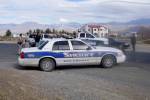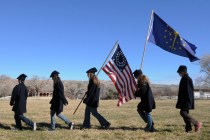Rainbow Basin offers a chance to see many fossils
Rainbow Basin, north of Barstow, Calif., offers cool-season visitors varied opportunities to enjoy a notable natural landscape. Visitors to this eroded, fossil-laden region explore multicolored formations and canyons. Activities include scenic touring, hiking, picnicking, camping, backpacking, horseback riding, wildlife watching and photography.
To reach Rainbow Basin, follow Interstate 15 south 160 miles to Barstow. Rainbow Basin lies abut eight miles from Barstow. Exit the freeway and find Barstow’s Main Street. Follow it to First Avenue and head north. Watch for Irwin Road and turn left. Proceed on Irwin Road until you spot the Rainbow Basin sign. Turn left on Fossil Bed Road, a gravel route. Head west abut three miles into Rainbow Basin.
Administered by the Bureau of Land Management as an area of critical environmental concern, the Rainbow Basin Natural Area protects unique geological features and significant fossil beds. Named for the colored rock formations and mineralized earth exposed by erosion in several canyons, the area includes both public lands and private in-holdings, such as land owned by the Southern Pacific Railroad, various mining interests and ranchers with grazing rights.
Although it lies just a few miles from Barstow, Rainbow Basin seems remote. Except for a developed campground and a narrow, one-way scenic loop road, the landscape seems little changed since frontier times. The BLM strives to keep it that way, barring the natural area for staging of off-road vehicles, closing old tracks to further use and restricting vehicular use to just two side roads. These policies prevent further degradation of the landscape and damage to fossils. They encourage native birds and animals to return to their natural habitat in the cliffs and small canyons, such as Owl, Coon and Fossil Canyons. Because of their vegetation, occasional water and protective cliffs, the canyons attract a variety of creatures best observed or photographed early or late in the day.
One short unpaved spur accesses Owl Canyon Campground, a 31-unit facility near one of the gravel-bottomed canyons open to hiking and horseback exploration. Open all year, the campsites typically have parking pads, tables and fire pits or grills. Available on a first-come basis for a $6 per night fee, the sites fill up fast on weekends and holidays. Centrally located restrooms are handicapped accessible. Depending on current conditions of the facility’s water tanks, water may not be available. Bring enough water for camp needs, at least a gallon per person per day, plus extra for cooking and clean-up. If you want a campfire, bring firewood. A self-contained camp stove is handy for cooking.
The other designated side road takes visitors through Fossil Canyon. This narrow, curvy, one-way loop route accesses areas where erosion exposes fossils deposited over millions of years on the bottom of a vast lake. Trapped in mud that eventually turned rock hard, multitudes of creatures from ages past survive as fossils. Additionally, the fossilized remains include ancient land animals from times when grassy plains bordered the lake. Occasionally mired and drowned, creatures such as camels, mastodons, three-toed horses, rhinoceroses and saber-toothed cats added their bones to the fossil record.
Signs on this road advise the use of high-clearance vehicles and no motor homes or vehicles hauling trailers. Unless wet or flash-flood damaged, the road actually can be negotiated by passenger vehicles driven carefully. Tight curves might be difficult for RVs and trailers. If you want to inspect the fossil beds, be sure to pull safely out of the travel lane and explore on foot.
Wind and rain continue to reveal the ancient remains that are protected from casual collectors.
People with legitimate professional or institutional interest in fossils must obtain permits to collect from the BLM office in Barstow. Those driving the Fossil Canyon route frequently see groups of university students on field trips to the fossil beds with their instructors. Fossils from this area enrich the collections of many universities and museums.
Margo Bartlett Pesek’s column appears on Sundays.


















